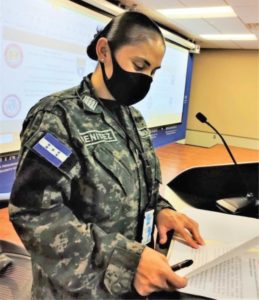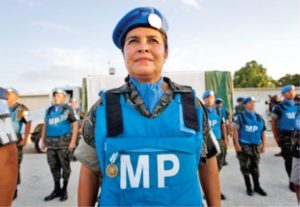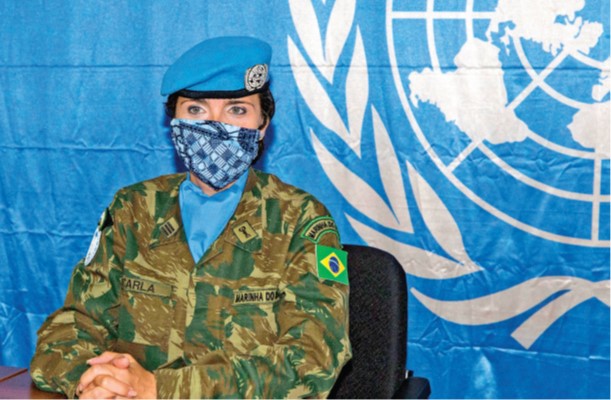The landmark United Nations Council Resolution (UNSCR) 1325 on Women, Peace, and Security (WPS), which addresses the importance of women’s full and equal participation in conflict resolution, peacebuilding, peacekeeping, humanitarian response, and post-conflict resolution, aims to mainstream gender in U.N. institutions and peacemaking processes of all governments.
Consistent with this, the resolution urges member states to “ensure increased representation of women at all decisionmaking levels in national, regional, and international institutions
and mechanisms for the prevention, management, and resolution of conflict.” Despite the codification of WPS in 2000, there is a persistent, widespread gender imbalance favoring
male personnel — women constitute less than 4 percent of the roughly 100,000 strong U.N. forces.
Four years after the resolution was adopted, the Security Council issued a statement encouraging member states to develop National Action Plans (NAP) to address UNSCR 1325. NAPs are national-level strategy documents that outline a government’s course of action for addressing WPS.

Benítez, member of WHINSEC’s
Center for Human Rights and
Democracy and guest instructor
at the institute, fine-tunes her
notes for a WPS-related event,
in March 2021. (Photo: Milton Mariani Rodriguez/WHINSEC)
COUNTRIES ALREADY THERE
In our hemisphere, seven countries have achieved this milestone to date: Brazil (2017), Canada (2010), Chile (2009), El Salvador (2017), Mexico (2021), Paraguay (2015), and the United States (2011). Four more countries: Costa Rica,Ecuador, Trinidad and Tobago, and Uruguay are currently developing NAPs according to a 2020 Women in International Security (WIIS) report.
Though the adoption of NAPs is celebrated as an important milestone in addressing WPS, there is little information available about their effect in increasing the participation of women in peacekeeping operations (PKO). Increasing the participation of women in PKOs is one of the aims of UNSCR 1325. The issue is addressed specifically in a stand-alone resolution, UNSCR 2538, which, adopted in 2020, calls for greater action to bolster the role of women in all levels of peacekeeping. While NAPs are encouraged and recognized as an important step toward meeting the goals agreed to at the U.N., the participation of women in peace processes is linked to their involvement in the military and police forces; as such, rates of female participation in security and defense processes might be a better predictor of female involvement in peacekeeping than the adoption of a NAP.
THE EXCEPTIONS: ARGENTINA AND URUGUAY
In Latin America, women constitute fewer than 10 percent of military personnel, with the exception of Argentina and Uruguay, in which women comprise 11.63 percent and 16.09 percent respectively.
These rates are reflected in the limited number of female peacekeeping personnel despite an impressive overall contribution of peacekeepers by countries in the region. Countries in the region, including Argentina, Bolivia, Brazil, Chile, Ecuador, Guatemala, Paraguay, Peru, and Uruguay contributed over 7,000 troops to the U.N. Mission in Haiti (MINUSTAH, in French). Despite this, the size of the overall contribution of women in the mission hovered around 2 percent. Latin American troop contributions specifically were about 2.5 percent female.
Beyond the hemisphere, Latin America has also made important contributions to peacekeeping. In 2018, for example, Latin American forces participated in 14 U.N. peacekeeping missions, with a total of 2,230 police and military service members. The high rates of overall participation, however, are not mirrored in rates of female participation. Of the thousands of personnel deployed
from the region only 4.3 percent of military personnel and 3.9 percent of military experts were women. Two factors can help explain this disparity: the nature of NAPs themselves and the relative importance of peacekeeping to Latin American countries.

contingent of the United
Nations Stabilization
Mission in Haiti (MINUSTAH,
in French) participate in a
medal award ceremony in
recognition of their service
in Port-au-Prince. (Photo: MINUSTAH)
First, NAPs are strategy-level documents. As such, they don’t include enforcement mechanisms. As suggested by their name, they outline a government’s plan for addressing all or some of the key issues included in the WPS agenda, but don’t include consequences for noncompliance and are most often not resourced.
The first U.S. WPS NAP, for example, included lines of effort and metrics, but did not make money available for pursuing those efforts. In contrast, since adopting the WPS Act in 2017, the U.S. Congress has specifically allocated funds to pursue activities related to this program. While NAPs can signal a strong commitment from the highest levels of national leadership to support WPS, they do not necessarily include the resources to do so.
Second, participation in PKOs is seen by Latin American troops as a prestigious assignment. Participation in PKOs is so cherished in the region that research suggests that assignments to these kinds of missions have been used to address discontent among the armed forces in certain countries. Assignments to PKO missions often also come with additional remuneration for the deployed personnel. The high attractiveness of a PKO assignment creates an opportunity for male personnel to be favored over female personnel. A NAP by itself cannot change the perception of the assignment or convincingly enforce gender quotas for such assignments.
To be successful at increasing participation of women in PKOs, countries in the region must advance beyond NAPs to create longer-term policies and ensure that the women that serve in such institutions have equal opportunity to participate in all assignments, including peacekeeping operations.









